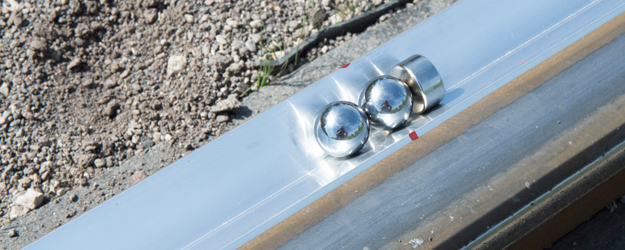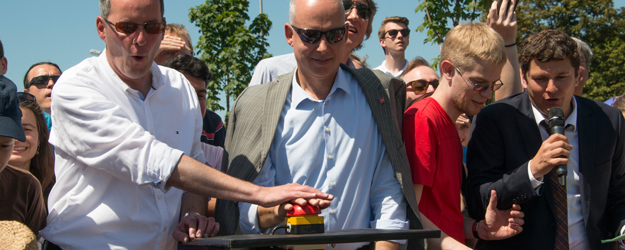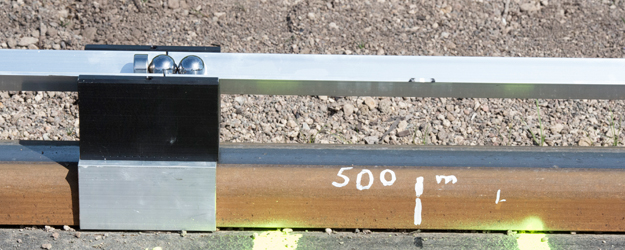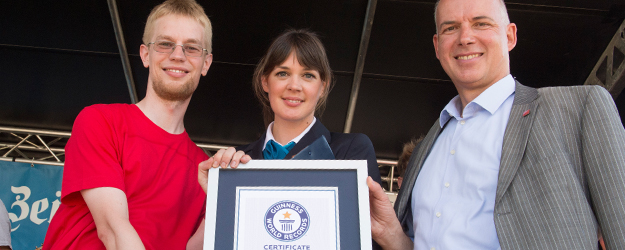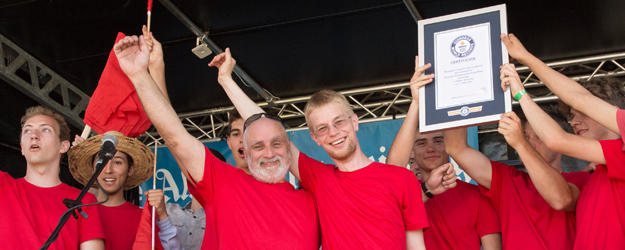12 June 2017
By constructing the longest magnetic ball accelerator in the world, Johannes Gutenberg University Mainz (JGU) set a new official Guinness World RecordTM. A team of physicists, supported by high schoolers from two schools in Mainz, worked for months on the project. The Mainz Public Transport Authority even cleared one of its tram lines for the world record experiment. When the final ball crossed the finishing line, the Mainz physicists started celebrating with hundreds of visitors of all ages.
One seems very nervous, the other appears to be the epitome of calm: Dr. Christian Schneider and Karl-Heinz Geib are walking along the 546-meter long ball track. In two hours, this track will immortalize JGU in the Guinness Book of World Records.
Construction started at 5:00 a.m. in the morning and it already promised to be a warm day. By 10:00 a.m., the temperature had increased significantly. "The track has already expanded by 20 centimeters due to its direct exposure to the sun," says Schneider. "In setting up the experiment, we assumed a maximum temperature difference of 15 degrees Celsius." He looks up into the blue sky. "I think the difference will be much greater today." The expansion joints between the individual aluminum rails have already closed so there is not much more leeway.
700 balls, 350 magnets
In everyday university life, Schneider is responsible for the schools program of the PRISMA Cluster of Excellence on Precision Physics, Fundamental Interactions and Structure of Matter. On this Sunday morning, however, he is out and about as the director of the world record project team. It was his idea to build the longest magnetic ball accelerator in the world.
"Christian came to me about a year and a half ago with the idea for the ball track," recalls Karl-Heinz Geib, mechanical engineer of the Experimental Particle and Astroparticle Physics (ETAP) group at the JGU Institute of Physics. At that time, the track for the Mainzelbahn, a new tram line for the city of Mainz, was just being built. It runs parallel to the campus. "We thought it would be easiest to set up our ball track on the tram rails." This provided the team with a more-or-less straight and solidly based substructure.
"The components for our ball track were made by the mechanical engineering workshop of the Institute of Physics," adds Geib. "The biggest job was sawing the many wooden blocks used to hold the aluminum track at regular intervals a few centimeters above the tram rails."
Students from two high schools in Mainz helped to put the track in place. In their red t-shirts with a specially created record attempt logo they can be seen bustling up and down the stretch to see that everything is in order. They have also put in place some 700 steel balls and 350 magnets for the record attempt. There has to be a magnet every one and a half meters on the track followed by two balls.
A party to celebrate the record
Chakir Laabdallaoni of the Rabanus Maurus high school explains how everything works. "A ball rolls up to a magnet, is attracted by the magnetic field, accelerates, and hits the next magnet." This impact is passed through the magnet and the first ball to the second ball, which then rolls away in the direction of the next magnet with its balls. The groups of pupils have already tried this out over shorter distances. "Everything went perfectly on our test run over 24 meters." But now the chain reaction must function perfectly over 546 meters. There are plenty of chances for things to go wrong.
"There is a risk of losing the magnetic field of the magnets on the aluminum rails if the temperature reaches 80 degrees Celsius or higher," says Schneider, conjuring up another personal nightmare. "That kind of temperature is possible on the tracks with direct sun exposure." The audience could also undermine the attempt. "What happens if a dog chases the balls?" Geib smiles and refuses to be made nervous.
The record attempt has come to represent so much more over the months during which it has been in preparation: Institutions involved with the PRISMA Cluster of Excellence and the Materials Science in Mainz Graduate School of Excellence are presenting their work, there are many talks and guided tours, for which abput 250 visitors have registered in advance. The Mainz physicists' band Quantum Noise is playing on its own stage, and naturally there are bratwurst and – in particular demand on this hot day – cold drinks. A range of local, regional, and national newspapers and broadcasters are there with their recording teams. Schneider gives interview after interview.
The idea for the longest magnetic ball accelerator in the world has achieved such resonance because it is not simply designed to be a PR stunt. The track has plenty to do with PRISMA itself. It is a simplified visual demonstration of what happens inside a particle accelerator, such as MAMI in Mainz.
PRISMA presents its research
Shortly before the world record attempt starts, the PRISMA coordinators Professor Matthias Neubert and Professor Hartmut Wittig explain to the assembled public what they are attempting to achieve. "For us as physicists, what we do here in Mainz is very exciting," emphasizes Neubert. "And we want to transmit this excitement to others."
Mayor of Mainz Michael Ebling pursues this same idea in his welcoming speech: "What's happening here is science in the city," he stresses. And Professor Konrad Wolf, Minister of Science, Continuing Education and Culture of the State of Rhineland-Palatinate, himself a physicist, emphasizes: "PRISMA is not only doing excellent science and research, it is also doing excellent science education." Together with Rhineland-Palatinate's Minister of Education Dr. Stefanie Hubig, Wolf has taken on the role of patron for the record attempt.
JGU President Professor Georg Krausch takes the opportunity to thank the city and its public transportation services: "Without their willingness to cooperate in something a little crazy like this and to put a halt to their tram traffic for half a day, none of this would have even been possible." Taking in the large crowd of curious spectators around the test track, he declares: "The project is already a complete success."
However, whether the attempt is judged a success by Guinness World Records is up to the official adjudicator Lena Kuhlmann. She has been in the records business for years and received specialized training for her job in London. "The track for this attempt had to be officially measured, and we have to ensure that no human is involved in accelerating the balls," she points out. Kuhlmann has adjudicated many record attempts. She has experienced both the weird and the simply ridiculous. "But weirdness is not what's going to count," she says. "It's achieving precision over such a long track that fascinates me about this record attempt."
The balls get rolling
Krausch and Ebling start the record attempt by jointly pressing the red button, which sets the first ball going. It is attracted by the first magnet and strikes it, and then the second ball rolls onwards to the second magnet. The chain reaction has started. Minister of Science Konrad Wolf is standing at the first checkpoint of the track and indicates that the ball, as planned, has passed his post by raising a red flag. Every 25 meters one of the high school students involved is standing, red flag in hand. To become a Guinness World Record, the chain reaction must continue without break over a distance of at least 500 meters; 546 meters of track have been constructed – a deliberate allusion to the date of reopening of Johannes Gutenberg University Mainz in May 1946.
Things get off to a quick start. The balls roll as planned. However, the balls then seem to be slowing down, at least from the point of view of the starting post. After a tense wait of several seconds, still no new flags. Have the magnets become too weak? No, the balls are still rolling. It would seem the balls are actually getting faster. They reach the 500-meter mark and roll on, all the way to the end.
Celebrations all round. Quantum Noise starts playing We are the champions. "That really was incredibly impressive," says adjudicator Lena Kuhlmann. She presents the record holders with their official Guinness World Records title certificate and adds with a happy and charming smile: "JGU is now 'officially amazing'."

